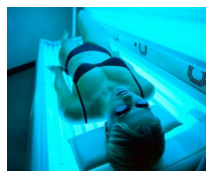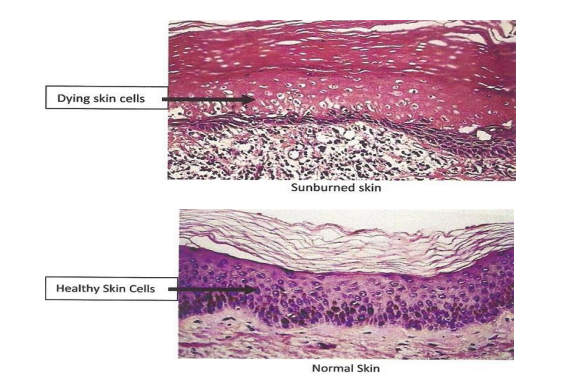The Tan to Die for

The World Health Organization has released an official report based on research by 20 scientists that UV emitting tanning devices unequivocally cause melanoma of the skin and eye. The risk of melanoma increases by 75% when tanning usage begins before age 35. There is currently an increase in the incidence of melanoma in women ages 15-39, which is most likely attributable to the popularity of tanning booths among young women. These findings substantiate current animal model studies that show a substitution of cytidine by thymidine in DNA after ultraviolet A radiation exposure. This same mutation is found in human skin cancers and human skin precancers in the tumor suppressor gene known as P53. Tanning beds can now officially join the infamous group of known carcinogens such as cigarettes and alcohol that are also prevalent in our culture.
If You Feel You Must Be Tan
I am frequently asked by patients if it is safe to go to the tanning booth “just a couple of times” to get a
“healthy glow” or to “prepare” their skin for sunbathing when they go to Hawaii. This is akin to asking how
many cigarettes a day it is it safe to smoke, which I have also been asked by patients.
This is my answer. If you feel you must damage your skin in order to “look tan and healthy,” actually going
to the beach for an afternoon is less damaging than going to a tanning booth for 20 minutes. One tanning
session exposes your skin to UVA levels that are equivalent to approximately 2 weeks of lying on the beach
in the summer.
Tanning Salons are Not Required by Law to Adhere to Any Safety Standards
The FDA does not regulate tanning parlors, thus they are not required to adhere to any safety standards. Tanning parlors do not routinely measure the output of UVA from their units (if ever). This should be done weekly and the light panels replaced as indicated by properly performed photometric readings. The FDA has established doses that are supposed to be the maximum exposure of UV radiation an individual has in 1 session. Technically, this dose is known as the minimal erythemal dose (MED), which is the lowest dose of radiation needed to make your skin turn red or pink. This may range from 10-30 minutes depending on the amount of UV emitted. In the first week of tanning, sessions are supposed to be limited to 0.75 MEDs per exposure. However, this is only a recommendation by the FDA and is not
enforced. Some tanning salons do not increase the MEDs gradually and some sell additional minutes of tanning beyond the MED. In fact, many tanning salons sell unlimited tanning plans. This means that if you choose, you can damage your skin with multiple visits to the salon on the same day. Some salons have installed hotter or high-pressure light bulbs than the systems have been approved to have, making the posted maximum time limits invalid.
How to Develop a Melanoma Faster
Salons also sell “tanning accelerators” or ‘tan enhancers,” which make your skin more sensitive to UV light and markedly increase the absorption of UV radiation. These products used in conjunction with the tanning beds will greatly increase your risk of developing skin cancer. You may be thrilled to be tanning faster, just be aware you will also be accelerating your development for melanoma. I urge you to do a self-skin examination every 2 weeks if you are frequenting tanning salons.UV radiation damages the DNA in skin cells and DNA repair enzymes. In addition, UV radiation suppresses the immune system so cancerous cells can freely grow without your immune system detecting and eliminating them. You can easily expose yourself to lethal doses of UVA radiation and have no symptoms. There is no redness or burning sensation of the skin with this type of ultraviolet radiation damage. There is no signal
to alert you that your skin has had enough damage. When you are on the beach, most people will retreat when they notice a sunburn. This is a sign of cell death from UVB overexposure. If you examine sunburned skin under the microscope, the cells are necrotic. They have lost their cellular structure and appear as pink amorphous blobs of disorganized, dying protein structures.

Everyone is at Risk
The October 2009 issue of Cosmopolitan reports a tragic account of a 27 y.o. woman who died from melanoma. She had been a regular tanning bed customer. She writes about her experience as she is dying from the melanoma. Anyone can develop melanoma. It is not a cancer that occurs only in the elderly. It can be unpredictably aggressive. If you notice a mole changing or a new mole, you should not delay seeing a dermatologist. The thinner the melanoma is, the better your chances of survival. Thin melanomas have a greater than or equal to 95% 10-year survival. Thick elanomas are associated with a poorer survival, with an overall survival of 45% for 1 year, 25% for 2 years, and 11% for 5 years (this is assuming the melanoma has spread to lymph nodes and other organs such as lung, brain, bone, etc.)
Be Smart About Tanning
The smartest way to get a tan is to use a sunscreen that contains a peptide that stimulates production of your own melanin in lieu of sun damage being the trigger for melanin production. Our office has this sunscreen available and it offers the best UVA protection (better than Mexoryl or Helioplex). I am also an advocate of the spray tan salons and self-applied bronzers containing dihydroxyacetone. This 3-carbon compound binds to the amino acids in the stratum corneum (the top layer of skin). It stains the skin a brown color, the intensity of which depends on the concentration of
DHA in the product, typically 2.5%- 10%. This product is not photoprotective and needs to be used with sunscreen when you are outside.
A melanoma may present as a pre-existing mole that starts to enlarge, change shape, size, color or begins to bleed or itch without any apparent cause. Approximately 70% of melanomas develop on the skin where there is no pre-existing mole. Dr. Patricia Wong recommends annual full body skin exams for adults. If you have 40 or more moles or have had a history of cancer or precancers, you should be examined more frequently for potential cancerous changes in your skin.